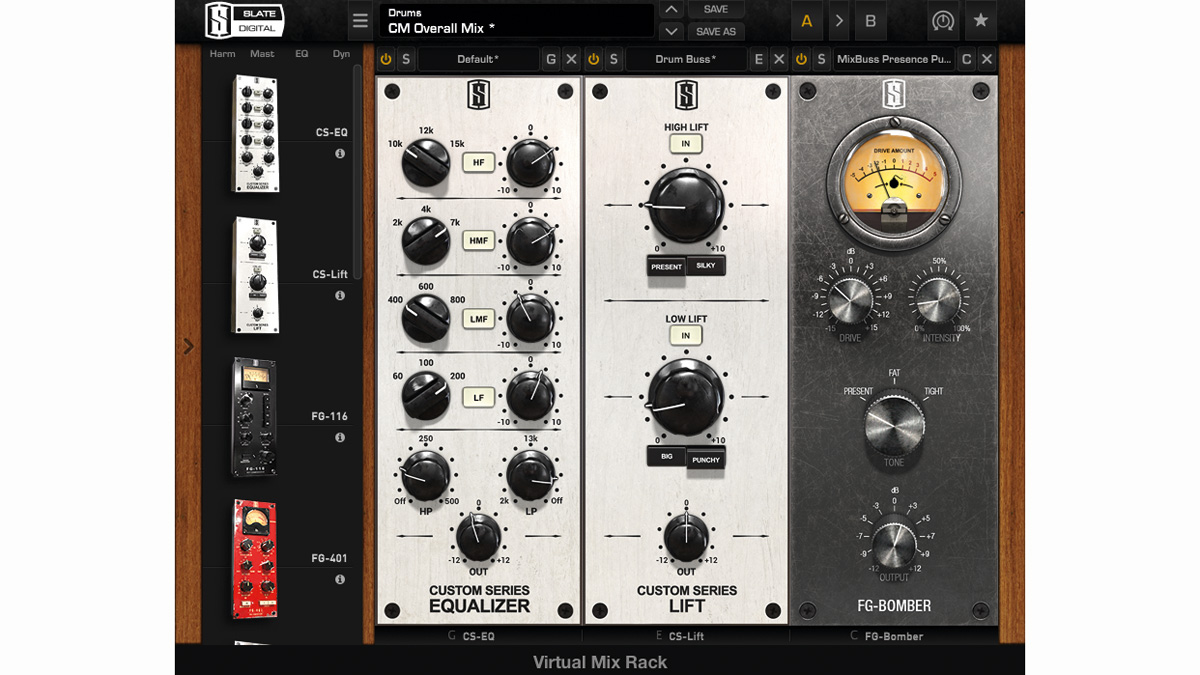MusicRadar Verdict
With Custom Series EQ, VMR becomes an even more flexible, interesting mix processing system.
Pros
- +
Excellent hybrid. Lift is a great sweetening tool Integrated output trim.
Cons
- -
Rack still lacks flexible routing. Plugins only work in the Rack.
MusicRadar's got your back
Slate Digital's Virtual Mix Rack is a rack-style modular effects plugin that hosts the company's range of proprietary processing modules.
On initial release a year ago, five such processors were available, four of them bought as a bundle (FG-N 'Brit-N' EQ, FG-S 'Brit-4K' EQ, FG-116 FET Compressor and FG-401 VCA Compressor), the fifth (Revival, a simple two-band EQ) included with the VMR rack itself - which is a free download - as a 'taster' option. A physical iLok 2 key is required for all VMR authorisations, including the rack and free plugin.
When VMR was launched, it was made clear that further modules would follow - and indeed they did. The first was a revised version of Slate's Virtual Console Collection, plus a free gain and phase reverse module (Trimmer). Now, the second wave is upon us in the shape of the two-module Custom Series Bundle ($149), comprising Custom Series EQ and Custom Series Lift, and FG-Bomber ($99), described as a "dynamic impact enhancer". Here we look at the Custom Series.
Playing the Classics
Custom Series EQ is a four-band hybrid emulation with additional high-and low-pass filters, based on custom combinations of classic hardware EQs. Slate doesn't say which ones specifically, but it does state the type.
When boosting, the HF (high frequency) band is a classic valve design combined with mastering EQ-style air, while the HMF (high-mid) band combines multiple discrete analogue designs, the LMF (low-mid) band is a mixture of valve and solid state, and the LF (low) band is modelled on two classic mastering EQs. In contrast, all the cut curves are based on a modern transparent mastering EQ.
The crucial thing here is that the boost curves emulate combinations of EQs rather than a single unit, and although this may seem like an odd approach, it actually emulates the way in which many pro mix engineers work. The frequencies are at fixed points, rather than sweepable, which is also to be expected given the finely tuned methodology.
The HF and HMF bands are great for adding focused edge and musical air to vocals, snares and acoustic sounds such as guitars and orchestral instruments. Viewed in a spectrum analyser, it's also clear that while the HF band is a peak filter, HMF combines peak and shelving shapes.
The behaviour is more typical in cut mode, with broad, predictable dips that are good for taming harshness in cymbals and electric guitars, but not narrow enough to notch out specific problem frequencies. Boosting with the LMF band delivers an incredibly broad peak that fills out the low mids, while the LF band boasts quite a steep shelf, aiding low-end weight. The low-and high-pass filters are very gentle, rolling off at about 6dB per octave.
Going up
Custom Series Lift is a two-band boost-only sweetening EQ based on the same hardware analysis behind Custom Series EQ. Each band (High and Low) has just two frequency settings and delivers up to 10dB of boost.
The result is upper mid articulation at 5kHz (Present), high air at about 10kHz (Silky), overall low end weight at 90Hz (Big) and peaking lows at 90Hz (Punchy). It's a simple concept with a musical sound that we fell in love with instantly, and although it's tempting to 'hype' everything with it, if you just stick to key elements such as vocals, beats, submixes and mixes, it's incredibly effective.
Put it on the slate
All three of Slate's new plugins make worthy additions to VMR, offering a fresh take on analogue-style audio processing.
We're still quite disappointed at the lack of internal rack routing options in VMR though, and the inability to use the plugins on their own away from it (or at least to collapse the interface down to show just the modules you're using, for instance).
Even so, we'll park that thought for now, and sum up by saying that this trio of new modules makes an excellent addition to the lineup.
Computer Music magazine is the world’s best selling publication dedicated solely to making great music with your Mac or PC computer. Each issue it brings its lucky readers the best in cutting-edge tutorials, need-to-know, expert software reviews and even all the tools you actually need to make great music today, courtesy of our legendary CM Plugin Suite.

“If it wasn’t for that song, that would have been the end of the band”: How one track’s sudden gear-switch led Coldplay into their imperial phase

“He was like, ‘You’ve got it all wrong, man": Mumford & Sons reveal what Neil Young told them about the way they were approaching their live shows and album recordings

How to write a ‘sticky’ hit: Pure luck can put you in the charts, but sticking around to make the big bucks needs pure science











